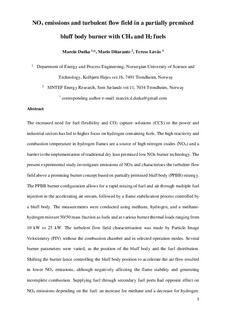| dc.contributor.author | Dutka, Marcin Damian | |
| dc.contributor.author | Ditaranto, Mario | |
| dc.contributor.author | Løvås, Terese | |
| dc.date.accessioned | 2018-02-27T13:00:06Z | |
| dc.date.available | 2018-02-27T13:00:06Z | |
| dc.date.created | 2016-06-29T13:02:13Z | |
| dc.date.issued | 2016 | |
| dc.identifier.citation | International journal of hydrogen energy. 2016, 41 (28), 12397-12410. | nb_NO |
| dc.identifier.issn | 0360-3199 | |
| dc.identifier.uri | http://hdl.handle.net/11250/2487395 | |
| dc.description.abstract | The increased need for fuel flexibility and CO2 capture solutions (CCS) in the power and industrial sectors has led to higher focus on hydrogen containing fuels. The high reactivity and combustion temperature in hydrogen flames are a source of high nitrogen oxides (NOx) and a barrier to the implementation of traditional dry lean premixed low NOx burner technology. The present experimental study investigates emissions of NOx and characterises the turbulent flow field above a promising burner concept based on partially premixed bluff body (PPBB) strategy. The PPBB burner configuration allows for a rapid mixing of fuel and air through multiple fuel injection in the accelerating air stream, followed by a flame stabilization process controlled by a bluff body. The measurements were conducted using methane, hydrogen, and a methane–hydrogen mixture 50/50 mass fraction as fuels and at various burner thermal loads ranging from 10 kW to 25 kW. The turbulent flow field characterisation was made by Particle Image Velocimetry (PIV) without the combustion chamber and in selected operation modes. Several burner parameters were varied, as the position of the bluff body and the fuel distribution. Shifting the burner lance controlling the bluff body position to accelerate the air flow resulted in lower NOx emissions, although negatively affecting the flame stability and generating incomplete combustion. Supplying fuel through secondary fuel ports had opposite effect on NOx emissions depending on the fuel: an increase for methane and a decrease for hydrogen. The temperature of the chamber has significant impact on NOx emissions and was quantified in the study with a 50% increase from a chamber temperature of 700 °C–1050 °C. NOx emissions are generally higher as the hydrogen content in the fuel increases. The lowest achieved NOx emissions are 26 and 66 ppm at 3% O2 dry for methane and hydrogen respectively. | nb_NO |
| dc.language.iso | eng | nb_NO |
| dc.publisher | Elsevier | nb_NO |
| dc.rights | Attribution-NonCommercial-NoDerivatives 4.0 Internasjonal | * |
| dc.rights.uri | http://creativecommons.org/licenses/by-nc-nd/4.0/deed.no | * |
| dc.title | NOx emissions and turbulent flow field in a partially premixed bluff body burner with CH4 and H2 fuels | nb_NO |
| dc.type | Journal article | nb_NO |
| dc.type | Peer reviewed | nb_NO |
| dc.description.version | acceptedVersion | nb_NO |
| dc.source.pagenumber | 12397-12410 | nb_NO |
| dc.source.volume | 41 | nb_NO |
| dc.source.journal | International journal of hydrogen energy | nb_NO |
| dc.source.issue | 28 | nb_NO |
| dc.identifier.doi | 10.1016/j.ijhydene.2016.05.154 | |
| dc.identifier.cristin | 1364960 | |
| dc.relation.project | Norges forskningsråd: 193816 | nb_NO |
| dc.description.localcode | © 2016. This is the authors’ accepted and refereed manuscript to the article. Locked until 8.6.2018 due to copyright restrictions. This manuscript version is made available under the CC-BY-NC-ND 4.0 license http://creativecommons.org/licenses/by-nc-nd/4.0/ | nb_NO |
| cristin.unitcode | 194,64,25,0 | |
| cristin.unitname | Institutt for energi- og prosessteknikk | |
| cristin.ispublished | true | |
| cristin.fulltext | postprint | |
| cristin.qualitycode | 2 | |

